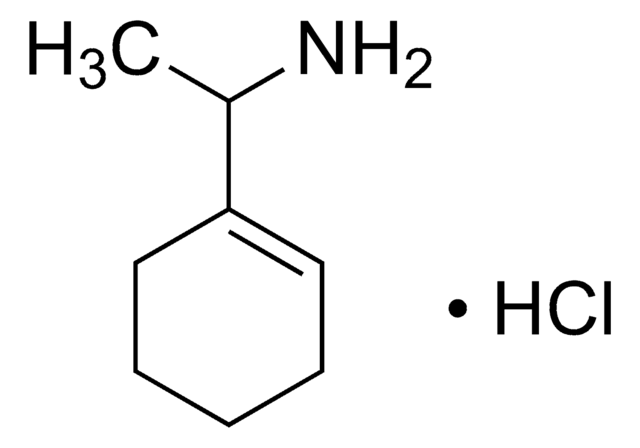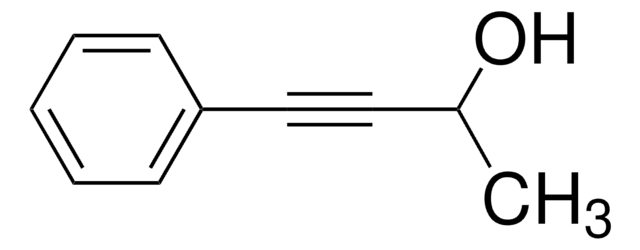E45309
Ethyl phenylpropiolate
98%
Se connecterpour consulter vos tarifs contractuels et ceux de votre entreprise/organisme
About This Item
Formule linéaire :
C6H5C≡CCOOC2H5
Numéro CAS:
Poids moléculaire :
174.20
Beilstein:
639637
Numéro CE :
Numéro MDL:
Code UNSPSC :
12352100
ID de substance PubChem :
Nomenclature NACRES :
NA.22
Produits recommandés
Essai
98%
Forme
liquid
Indice de réfraction
n20/D 1.552 (lit.)
pb
260-270 °C (lit.)
Densité
1.055 g/mL at 25 °C (lit.)
Température de stockage
2-8°C
Chaîne SMILES
CCOC(=O)C#Cc1ccccc1
InChI
1S/C11H10O2/c1-2-13-11(12)9-8-10-6-4-3-5-7-10/h3-7H,2H2,1H3
Clé InChI
ACJOYTKWHPEIHW-UHFFFAOYSA-N
Vous recherchez des produits similaires ? Visite Guide de comparaison des produits
Code de la classe de stockage
10 - Combustible liquids
Classe de danger pour l'eau (WGK)
WGK 3
Point d'éclair (°F)
Not applicable
Point d'éclair (°C)
Not applicable
Équipement de protection individuelle
Eyeshields, Gloves
Faites votre choix parmi les versions les plus récentes :
Déjà en possession de ce produit ?
Retrouvez la documentation relative aux produits que vous avez récemment achetés dans la Bibliothèque de documents.
Les clients ont également consulté
B H Shearer et al.
Journal of oral pathology & medicine : official publication of the International Association of Oral Pathologists and the American Academy of Oral Pathology, 23(4), 149-155 (1994-04-01)
The effects of four different hyperplastic agents and of the carcinogen DMBA on cytokeratin expression in hamster cheek pouch epithelia were compared. Reversible hyperplasia was produced by the application of either oil of turpentine, vitamin A or TPA. No hyperplastic
C S Baxter et al.
Carcinogenesis, 10(10), 1855-1861 (1989-10-01)
Responses of various cells of the epidermis and dermis to topically applied agents have been implicated in the mechanism of multistage mouse tumorigenesis. These responses have been discussed almost entirely in the context of a single promoter treatment, although tumor
E Patrick et al.
Toxicology and applied pharmacology, 81(3 Pt 1), 476-490 (1985-12-01)
The possibility that chemicals induce skin irritation by multiple mechanisms was studied in laboratory mice. The time course and dose response to topical application of phenol, croton oil, benzalkonium chloride, ethyl phenylpropiolate (EPP), and methyl salicylate were compared. The responses
S K Gilmour et al.
Carcinogenesis, 13(1), 51-56 (1992-01-01)
Single applications of 12-O-tetradecanoylphorbol-13-acetate (TPA), mezerein or ethyl phenylpropriolate (EPP) to mouse skin at appropriate doses cause similar degrees of hyperplasia and comparable levels of induction of epidermal ornithine decarboxylase (ODC) activity. Multiple (n = 5) treatments with these agents
G S Cameron et al.
The Journal of investigative dermatology, 99(2), 189-192 (1992-08-01)
The dorsal skin of hairless mice (Skh:HR-1) was treated with multiple applications of acetone, 12-O-tetradecanoyl-phorbol-13-acetate (TPA) or ethyl phenylpropionate (EPP) two times per week, or exposed to ultraviolet radiation (UVR) three times per week for treatment periods up to 16
Notre équipe de scientifiques dispose d'une expérience dans tous les secteurs de la recherche, notamment en sciences de la vie, science des matériaux, synthèse chimique, chromatographie, analyse et dans de nombreux autres domaines..
Contacter notre Service technique












